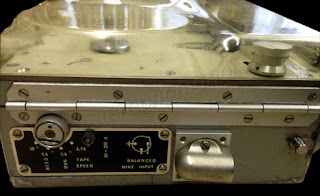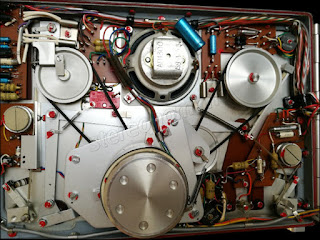NAGRA III
(1957) DC servo controlled electric motor. Germanium transistors
The Nagra
III is a self contained professional tape recorder, assuring an excellent
reliability factor, and the best recording quality available outside your
studio. The frequency response, Signal-to-Noise and wow and flutter
characterisctics of the Nagra III, are
similar too those of the best studio consol recorders, but modulation noise is
even better.
Motor and
speed stabilizer
The motor of
the Nagra is of the permanent magnet electrodynamic type and resembles a
d'Arsonval galvcanometer with central magnet. The Nagra III uses a new
technique for controlling the speed of the motor.
The motor
carries on its spindle a phonic wheel as well as the capstan, which passes in
front of a magnetic head - the tachometer head. This head is magnetised and the
rotation of the phonic wheel induces an alternating current, the frequency of
which depends upon the speed of rotation of the motor. This passes through the
tachometer amplifier where it is shaped into a square wave of constant
amplitude of about 6 volts peak to peak. This output is taken to a frerquency
discriminator. This operates the servo amplifier which controls the motor
speed. As the voltage at the servo amplifier becomes increasingly negative, so
the motor current will increase.
Microphone
preamplifier
This Nagra
is equiped with a new type of microphone preamplifier designated LN. This
preamplifier permits the selection of input impedance between 50 Ω and 200 Ω. All that is necessary
to do in order to change from one impedance to the other, is to rewire
internally the connections on the input transformer.
Specifications:
Electronics: 38 Transistors, 15 Diode, 1 Zener Dode
Tape
Speed: 15 ips, 7,5 ips, 3-3/4 ips
Reel
Diameter: 7" with cover open,
5" with cover closed
Speed
Regulation: 0,05% or better 60/50 Hz
buil-in stroboscope
Rewind: fast rewind and fast forward controls
Magnetic
Heads:
1 High
frequency erase head with double gap;
1 Full track
record head;
1 Full track
playback head;
1 Neopilot
sync track head with high frequency bias
Equalization: NAB
Inputs:
1 x
Microphone : 50 - 200 Ω impedance
1 x Line (
600 Ω) or Bridging (100 k Ω)
Line input
with BS preamplifier can be used for separate mixing of second microphone.
Line input
with BM mixer can be used for separate mixing of three extra microphones plus
line input.
Oscillator
Frequency: 65 kHz
Output
Level: +15 dbm
Output
Impedance: 600 Ω
Frequency
Response:
At 15 ips
: 30 c/s to 18,000 c/s ±1 dB
At 7-1/2 ips
: 40 c/s to 15,000 c/s ±1 dB
Signal-to-Noise
Ratio: 75 dB at 15 ips
Erasure: - 80 dB
Temperature
Range: -4° F to +122°F
Power
Consumption:
85 mA : in
test mode
175 mA
: in Playback mode
205 mA
: in Recording mode
Batteries: 12 standard Flashlight "D" Cells
Dimensions
: 12,5 x 8,7 x 4,3 inch
Weight
: 13 lb 13 oz
Recorder
Case: Rugged lightweight metal






could i run a stereo piano track through this?
RispondiElimina